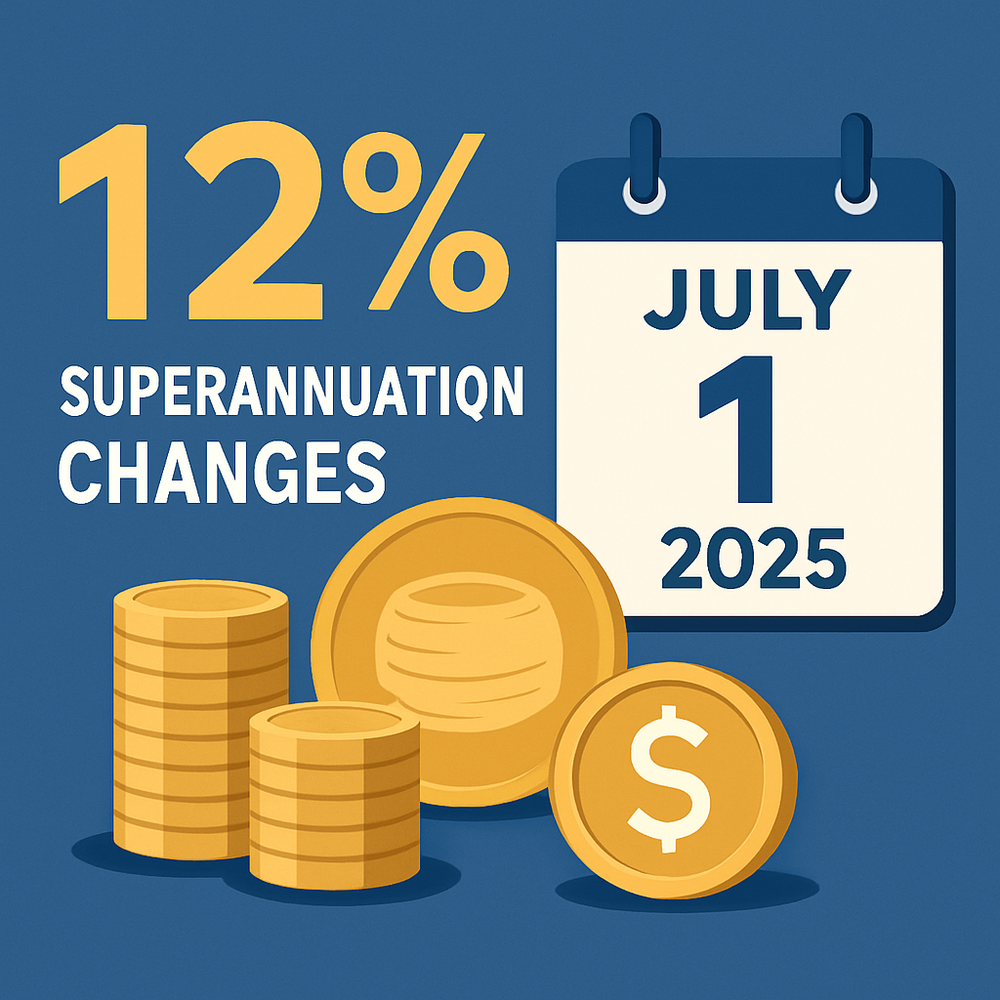What You Need to Know
The Australian superannuation landscape will undergo several important changes from July 1, 2025. These changes will affect employers, employees, and retirees across the country. Here’s what you need to know about the upcoming superannuation reforms.
Superannuation Guarantee Reaches Target 12%
From July 1, 2025, the Superannuation Guarantee (SG) rate will increase from 11.5% to 12%. This marks the final step in the government’s long-term plan to boost retirement savings for all working Australians. Employers must contribute this minimum percentage of an employee’s ordinary time earnings to their superannuation fund. If your employment agreement specifies a higher contribution rate, your employer must continue to honor that higher rate.
Transfer Balance Cap Rises to $2 Million
The general transfer balance cap—the maximum amount you can transfer into tax-free retirement phase accounts—will increase from $1.9 million to $2 million. This adjustment reflects indexation in line with inflation.
If you’re starting a pension for the first time after July 1, 2025, you’ll have access to the full $2 million cap. If you’ve already started a pension but haven’t used your full cap, you may receive a proportional increase based on your unused cap space.
The defined benefit income cap will also increase to $125,000 for the 2025-26 income year, up from $118,750.
Total Super Balance Cap Increases
The Total Super Balance cap will rise to $2 million, matching the transfer balance cap. This threshold determines your eligibility for various superannuation benefits and concessions, including:
- Non-concessional contributions and bring-forward arrangements
- Carry-forward concessional contributions
- Spouse tax offset
- Government co-contributions
Contribution Caps Remain Steady
For the 2025-26 financial year, contribution caps will remain unchanged:
- Concessional (before-tax) contributions: $30,000
- Non-concessional (after-tax) contributions: $120,000
These caps are particularly important if you’re making voluntary contributions through salary sacrifice or personal after-tax contributions.
Maximum Super Contribution Base Decreases
In an unusual development, the maximum super contribution base will decrease to $62,500 per quarter (down from $65,070). This is the maximum earnings amount employers use when calculating super contributions for high-income employees.
With the new 12% SG rate, the maximum quarterly SG contribution will be $7,500 per quarter. Employers with high-income staff should review their payroll settings to ensure compliance with this revised cap.
Higher Tax for $3 Million+ Super Balances
Following the recent election, the government will proceed with its plan to increase the tax rate on superannuation balances exceeding $3 million. The tax rate will double from 15% to 30%, including on unrealised capital gains. This measure, known as Division 296, is subject to parliamentary approval.
Looking Ahead: Payday Super Coming in 2026
While not a 2025 change, employers should begin preparing for “payday super,” scheduled to commence on July 1, 2026. This reform will require superannuation to be paid at the same time as wages, rather than quarterly. Updating payroll systems and processes in advance will help ensure a smooth transition.
Broader Financial Reforms
The government is also advancing its Delivering Better Financial Outcomes reforms, which will enable super funds to provide more targeted personal advice to members on investment choices, retirement options, and insurance coverage.
Additionally, tax cuts are planned for all taxpayers, with the lowest income tax bracket rate reducing from 16% to 15% from July 1, 2026, and to 14% from July 1, 2027.
What This Means For You
These changes represent significant developments in Australia’s superannuation system. Whether you’re an employer, employee, or retiree, understanding these updates will help you make informed decisions about your retirement planning and ensure compliance with the latest regulations.
Disclaimer: This article is based on authoritative sources including AustralianSuper (“FY26 Superannuation Changes for Employers,” May 8, 2025) and SuperGuide (“Super news for May 2025,” May 8, 2025). While we strive to ensure the accuracy and completeness of the content, superannuation policies may change at any time. Readers should refer to the latest official information published by the Australian Taxation Office (ATO) and relevant government departments. The information provided in this article is for general reference only and does not constitute personalized financial, tax, legal, or investment advice. Each individual’s financial situation and needs vary. Before making any financial decisions, it is strongly recommended to consult qualified financial advisors, accountants, or legal professionals to obtain professional advice tailored to your personal circumstances.
Want to know more?
If you’d like to discuss any of the content in this article and how it may apply to you, please call me on 1800 668 153.
You can also book a discovery call thru our live calendar.
We love hearing from our readers! Please send us your questions, feedback or interest topic by clicking here.
Author Profile: Jeffrey Liu, JP, is the founder and principal adviser of Hippo Insurance (aka: Hippo Wealth), with a deep expertise in wealth protection. His extensive experience includes roles in the wealth management divisions of Westpac, ANZ, and a local multi-family office. As the host of “Riches Talk,” a podcast dedicated to cultivating personal and business growth, Jeffrey has established himself as a thought leader in developing life riches. His insights have been featured on SBS, The Australian, and Channel 7. Notably, he was a semi-finalist on Australia’s Got Talent in 2010. Learn more at http://www.hippoinsurance.com.au





